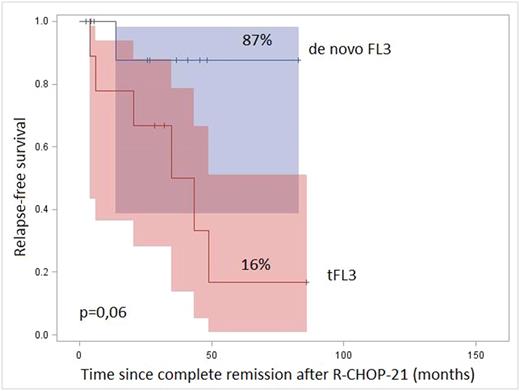Abstract
Actuality: FL3 is a heterogeneous group of follicular lymphomas. Detailed morphological, immunophenotypic and genetic characteristics of FL3 allow to explain clinical heterogeneity of the disease and to develop differentiated therapeutic approaches.
Aim: to characterize clinical, morphological, immunohistochemical (IHC) and genetic features of follicular lymphoma (FL) grade 3 and assess their prognostic value in patients treated with R-CHOP-21.
Materials and Methods: In this retrospective and prospective study, 93 primary patients with FL3 (median age 53 years, range 21 - 78 years, f:m=1:1,4) observed in «National Research Center for Hematology» in Moscow, Russian Federation (2001-2016), were included. Morphological and IHC studies of the lymph nodes and corresponding bone marrow trephines obtained prior to therapy have been carried out. Standard cytogenetics or FISH for BCL-2 have been performed.
Results: Two variants of the disease were identified: de novo FL (n=22) and transformed FL (tFL) - as a result of histological transformation of low grade follicular lymphoma (n=21). De novo FL3 was characterized by CD10 negativity (86%), MUM1 positivity (90%, with strong monotonous staining), absence of BCL-2 rearrangement (100%), although BCL-2 was found positive in 78% of cases. Bone marrow involvement in cases of de novo FL3 was rare (33%), and in all positive cases - with plenty of large lymphoid cells (centroblasts). tFL3 was positive for CD10 (90%), BCL-2 (95%) and carried rearrangements of BCL-2 in 90%. MUM1 was positive in 76% (heterogeneous staining) and negative in 19%. Bone marrow involvement was documented in 67 %, in most cases with predominance of small lymphoid cells - centrocytes (71%). These data were included in the algorithm for differential diagnosis of two variants of FL3. There was no correlation between the 2 variants of FL3 (de novo or transformed) and grades (3A, 3B or 3A+B) (p=0,11). 26 (60 %) patients from the whole group were treated with R-CHOP-21. The 5-year relapse-free survival of pts with de novo FL3 was 87% compared to 16% for pts with tFL3 (p=0,06), Me=41 months (Figure 1).
Conclusion: Two variants of FL3 are described: de novo FL and tFL, which are characterized by different morphological, IHC and genetic features and have various sensitivity to immunochemotherapy.
No relevant conflicts of interest to declare.
Author notes
Asterisk with author names denotes non-ASH members.


This feature is available to Subscribers Only
Sign In or Create an Account Close Modal